Are Springfree Trampolines Really the “Safer Trampoline?”
Looking for a safer trampoline? Find out if Springfree Trampolines are really the safest trampoline for your family, backed by data and honest information.
min read
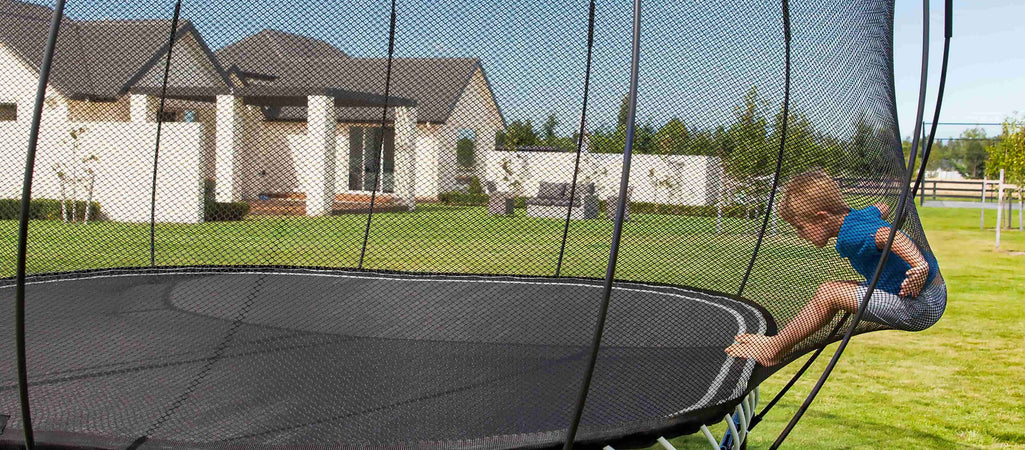
When it comes to trampolines, safety is of utmost importance to parents or guardians of children.
Being that there are over 100,000 trampoline injuries per year, the type of trampoline you buy is paramount to ensuring the safety of your jumpers. But which trampoline is the safest?
Our Springfree Trampolines, with their springless design, “hidden frame,” and flexible net, naturally come up quite a bit in the “safest trampoline” conversation. What’s the truth, though—Are Springfree’s really safer?
We will answer that critical question today. But we’re going to do it honestly, transparently and with empirically backed data instead of carelessly gloating about “all the great things about our trampolines!”
You deserve to know the truth to make an informed decision on your next trampoline. So, even though we’re assessing our own Trampolines’ safety compared to other brands, this will be a brutally authentic evaluation.
After reading this, you will know unequivocally whether Springfree Trampolines are the safer trampoline---let’s get to it!
Top Trampoline Safety Concerns
Before talking about Springfree Trampolines, let’s establish an understanding of trampoline injuries. If you have a quality trampoline, adhere to the trampoline’s weight limit and follow basic safety rules—like one jumper at a time and no roughhousing, then trampolines are safe and can be enjoyed for the long haul.
However, there are dangers to trampolines if they are not used properly. Below is data that demonstrates the common types of trampoline injuries and when they occur. Keep these in mind, as we will reference some of them later on when discussing Springfree’s safety features:
-
90% of trampoline injuries occur to children ages 5-14.
-
75% of trampoline injuries occur when multiple children are jumping on the trampoline.
-
27%-39% of injuries are caused by falling off the trampoline.
-
20% of injuries are caused by contact with the trampoline springs or frame.
-
36% of trampoline injuries are to the lower extremities.
-
About 52% of trampoline injuries are soft tissue injuries; fractures account for about 35% of injuries.
All data courtesy of the American Academy of Orthopedic Surgeons and Policygenius.
The data around trampoline injuries is important because it displays the potential hazards of trampolines if you buy the wrong one and/or don’t follow basic trampoline safety rules.
But if you buy the right trampoline, you can negate many of the causes of trampoline injuries. Next, we’re going to discuss the rationale behind the Springfree Trampoline invention before discussing the specific safety features of the Trampolines and how they provide solutions to the problems listed above.
What Are Springfree Trampolines?
Introduced in 2003 after a decade-plus of invention efforts, Springfree Trampolines were built as an alternative to the traditional spring-based trampoline.
Dr. Keith Alexander, the inventor of the Springfree Trampoline, wanted to build a safer trampoline that his kids could jump on. After several initial prototypes, the finished design of the springless trampoline came to fruition—with distinctive features we will discuss in the next section.
Springfree currently sells nine springless trampolines and is the only mainstream trampoline brand to exclusively sell trampolines with no springs.
5 Springfree Trampoline Safety Features
Now comes the important answer to the question: “Are Springfree Trampolines safer?”
Here are the five notable safety features that will help answer that question:
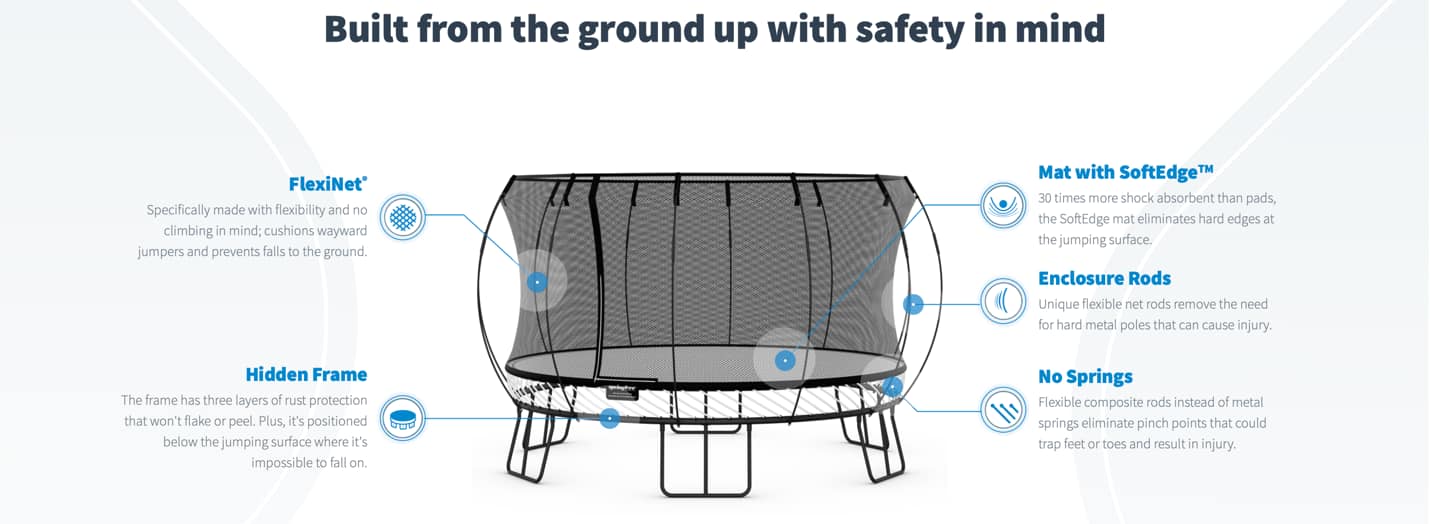
-
No Springs
The feature embedded into the name of the brand, Springfree Trampolines have no metal trampoline springs, which is a common place for pinching injuries on traditional trampolines.
Instead, Springfree Trampolines use patented flexible composite rods that are 3x stronger than steel to provide the Trampolines’ bounce, eliminating pinch points and the chance of hands or feet getting trapped.
Summary: Springfree Trampolines’ springless design eliminates spring-related injuries, which cause around 20% of all trampoline injuries.
The mat rods that replace the springs on a Springfree Trampoline:
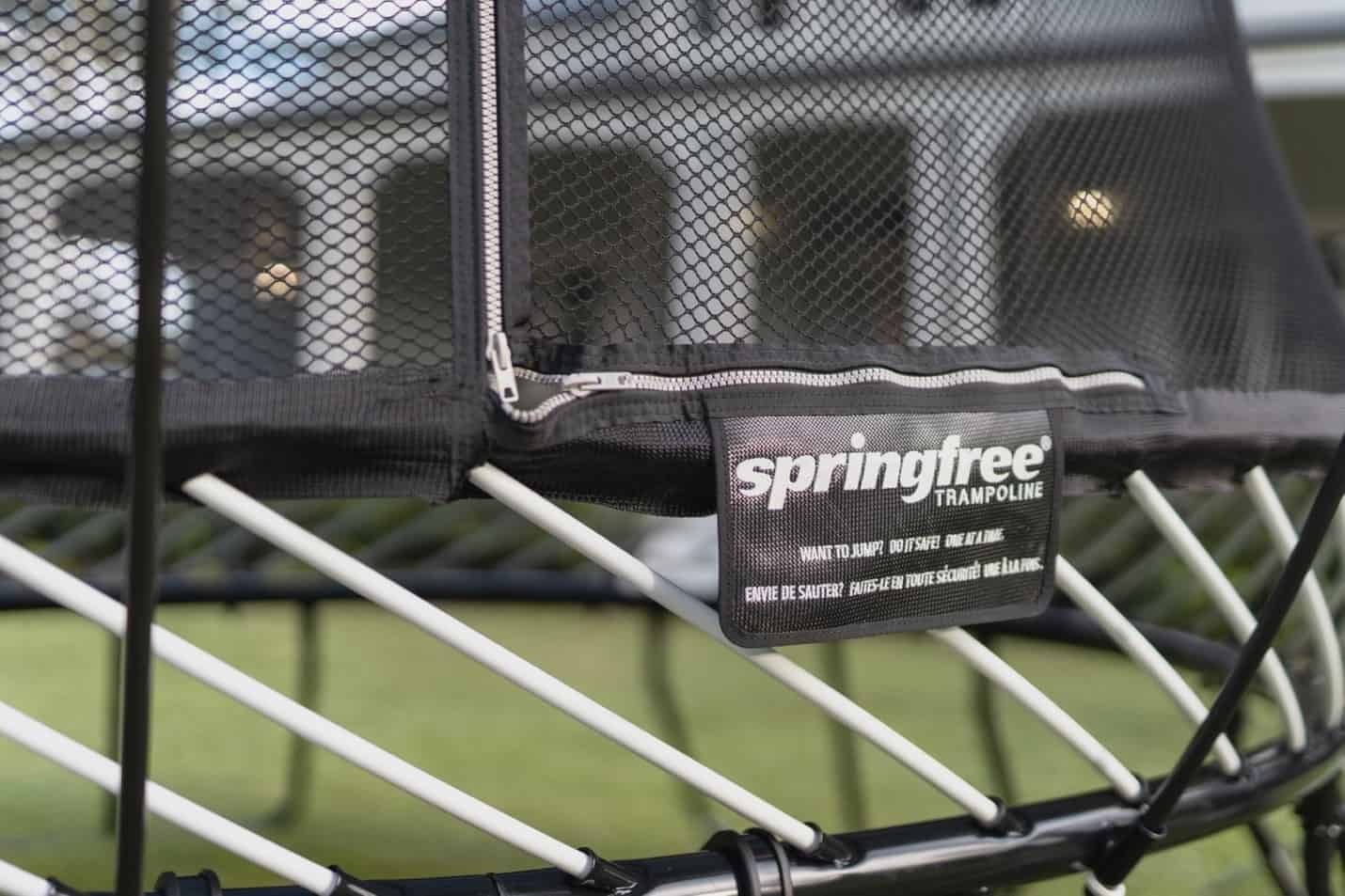
-
Flexible Net
Most modern trampolines have nets, but many of them—particularly the cheap trampolines—are made from inexpensive material that can wear down quickly and cause wayward jumpers to fall from the trampoline.
Springfree’s answer was to create a net that flexes when jumped into. Instead of falling straight to the ground, the next cushions jumpers that fall into it, thereby eliminating falls to the ground. The net is also UV-resistant and is made from similar materials to the nets used in deep-sea fishing.
Summary: Almost 40% of trampoline injuries can be attributed to falling off the trampoline. Springfree’s FlexiNet helps eliminate falling injuries while also being built with premium materials that ensure its longevity.
-
Mat With No Hard Edges
One of Dr. Alexander’s chief initiatives when he first began to build the Springfree Trampoline was to eliminate the hard edges—a common cause of concern on traditional trampolines.
The final result was Springfree’s SoftEdge Mat, which is 30 times more shock absorbent than safety pads that cover the springs on spring-based trampolines.
Summary: Springfree’s mat, which has no hard edges, eliminates any chance of injury from landing on the edge of a trampoline while jumping.
-
Hidden Frame
In the data discussed in the first section, landing on the trampoline frame helped account for up to 40% of trampoline injuries.
Springfree Trampolines are built with a frame that is “hidden” from the jumper’s point of view. The frame is positioned well below the jumping surface, making it impossible to land on when jumping.
It also comes with three layers of rust protection and is made from powder coated galvanized steel to strengthen its structure against age-related deterioration.
Summary: Springfree’s trampoline sturdy steel frame is positioned underneath the jumping surface and away from the jumper, eliminating any chance of contact with the frame.
A view of the hidden frame:
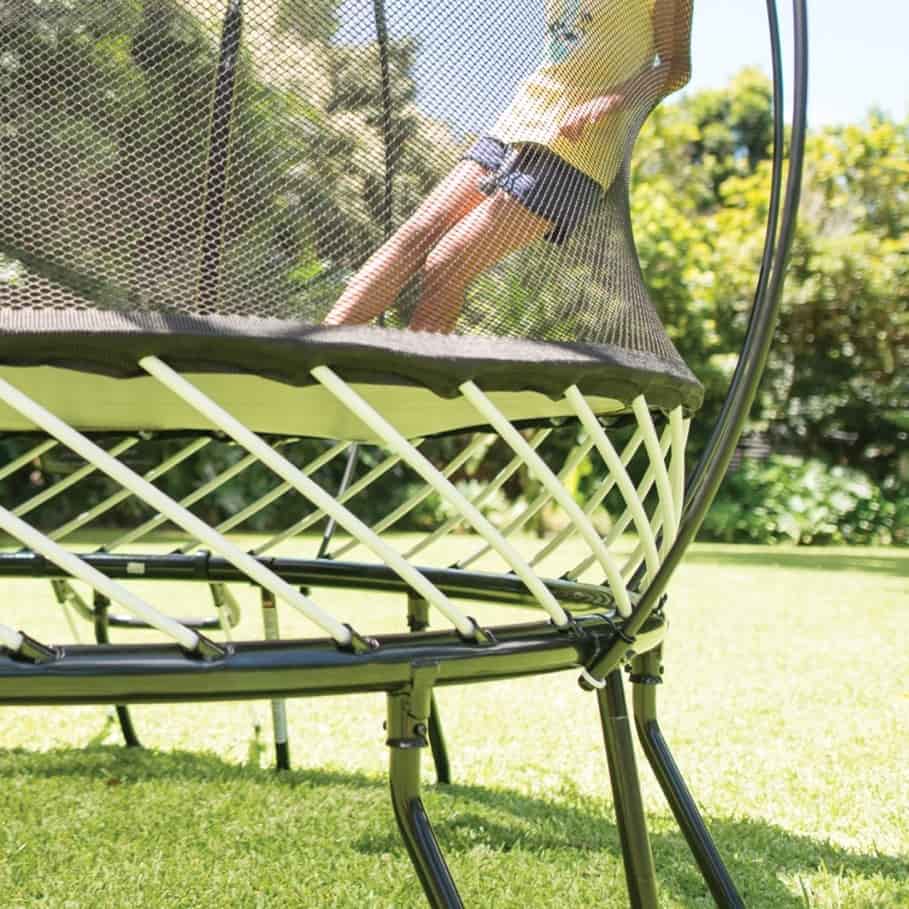
-
No Metal Trampoline Poles
Traditional trampolines typically use metal trampoline poles to hold the trampoline in place. This is a potential safety hazard because wayward jumpers can hit the poles and suffer an injury if they jump with enough force into the net.
Springfree Trampolines use flexible enclosure rods as a substitute for hard metal poles, eliminating another source of trampoline injuries.
Summary: Springfree Trampolines’ enclosure rods eliminate the need for metal poles, which can cause contact injuries on traditional trampolines.
To see a video of Dr. Alexander, the inventor of Springfree, comparing traditional and springless trampolines, check out the video below:
Springfree Trampoline Safety Awards
Largely for the safety features that were just discussed, Springfree Trampolines have received various awards for its trampoline safety efforts. Here are some of the awards won in the last two years by Springfree:
Springfree Trampolines have also received high ratings from verified users on noted platforms like Google, Amazon and Walmart. See below for review counts, courtesy of Google:
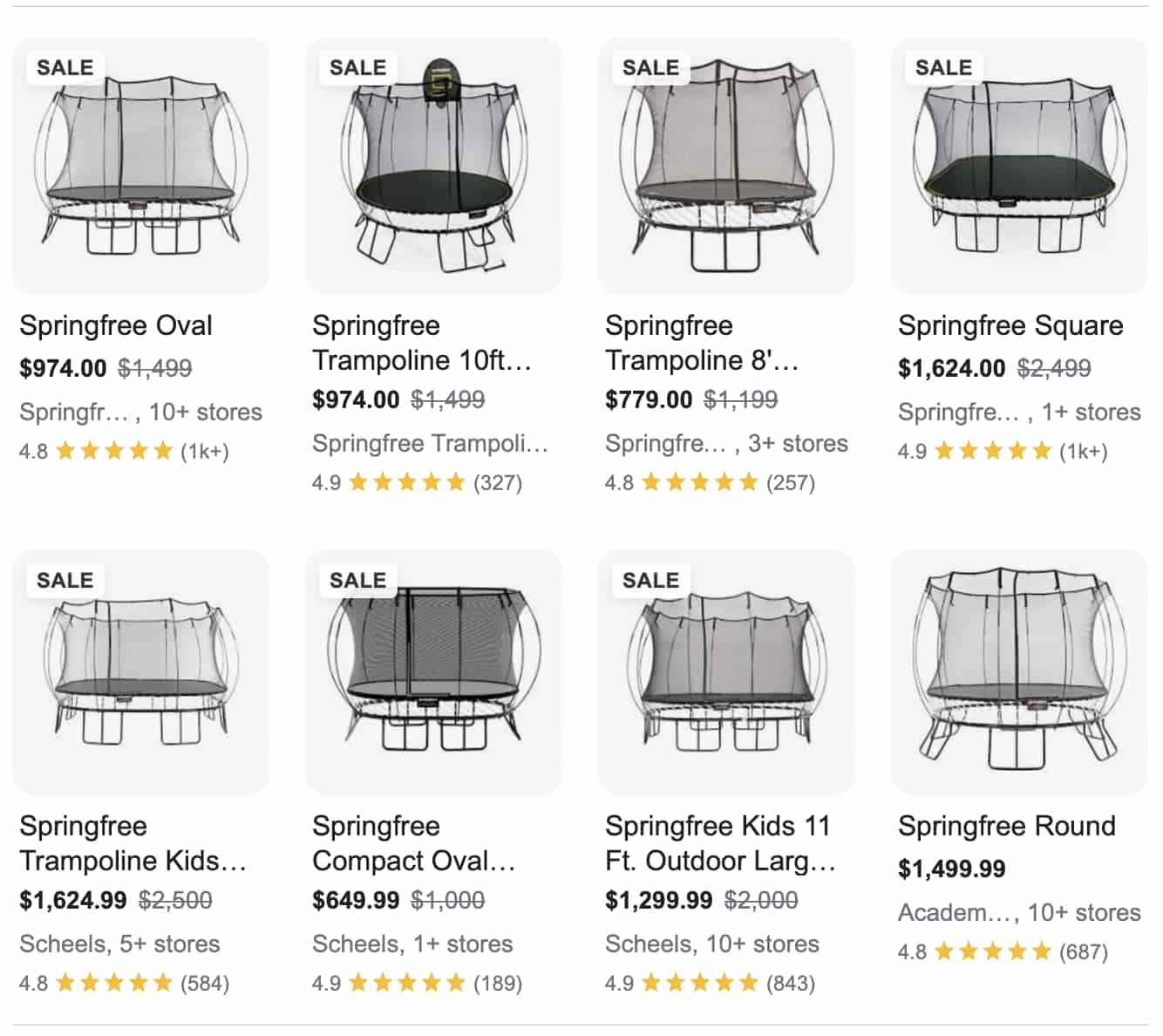
In addition to all the accolades Springfree has earned for its safety efforts, they are also the only type of trampoline to eliminate 90% of product-related injuries.
The Verdict: Is Springfree the Safer Trampoline?
It’s time to answer the ultimate question: Are Springfree Trampolines safer?
Based on safety features, awards and results of independent research, Springfree Trampolines can reasonably be considered the safest trampoline on the market.
Now, does that mean Springfree Trampolines are the best trampoline for you? No.
Because they are the safest, Springfree Trampolines are priced at a premium, with a price range of $799-$3,999. Understandably, some people can’t justify paying thousands of dollars for a trampoline.
But with that price, you get a trampoline that you don’t have to worry about your kids getting injured on, assuming reasonable use. For families looking for a safer trampoline, a Springfree Trampoline could be worth the price. Speaking of…
Are Springfree Trampolines Worth the Money?
You now understand why Springfree Trampolines are considered to be the safest trampoline for both kids and adults, but is a Springfree worth the money for you?
That is a question that is ultimately up to you to answer. But just like this article, we can use our expertise and honesty-first approach to help guide you.
We’ve previously laid out all the major positives and negatives of our Springfree Trampolines in a fully-fledged, detailed guide.
Reading through the article linked below (or watching the video) will help you see both sides of Springfree—the good and bad---so you can fully comprehend whether one is right for you.
Check it out: Are Springfree Trampolines Worth the Money?


